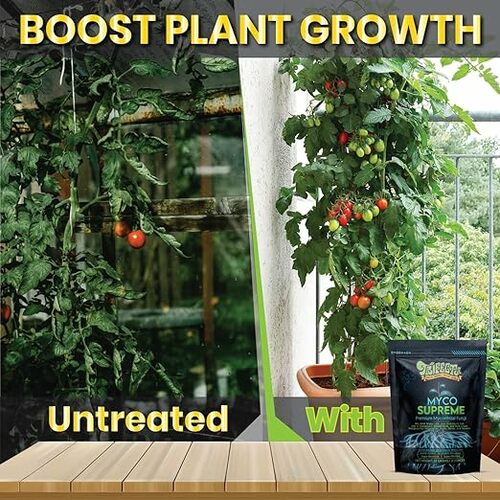A Guide to Vertical Mulching
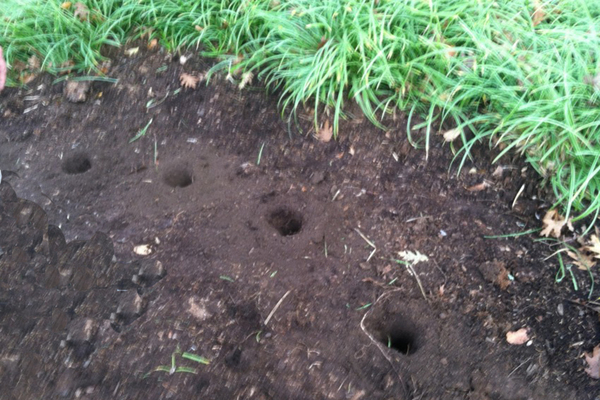
A Comprehensive Guide to Protecting and Nourishing Tree Roots
Tree lovers and arborists understand that a tree's beauty and strength extend far beyond its visible features. What lies beneath the soil is a crucial element in a tree's well-being. In this extensive guide, we will explore the critical root zone (CRZ) and why it's vital to protect it. We'll delve into the concept of vertical mulching and unveil additional aspects of tree care that contribute to a tree's long-term health and resilience.
Those who cherish trees may not be aware that over 80 percent of the root system of a tree occupies a zone about one foot below the surface of the soil where sufficient oxygen necessary for the tree to survive remains.
The Critical Root Zone (CRZ)
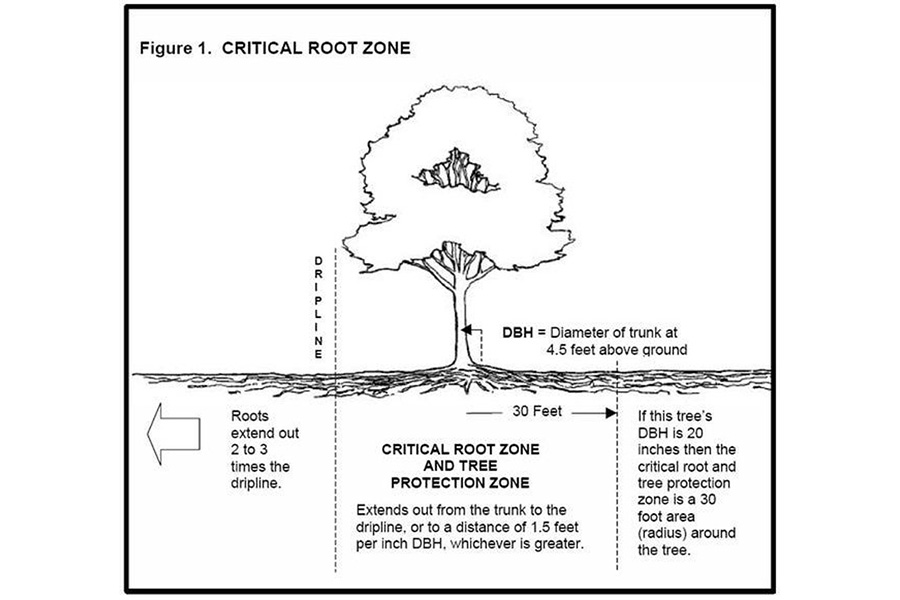
Critical Root Zone. Photo Credit: Athens-Clarke County Community Tree Program, Georgia
The critical root zone (CRZ), often called the "tree protection zone," is a concealed but vital component of tree care and maintenance. This zone is defined as an imaginary circle on the ground that corresponds to the "dripline" of the tree, which marks the outermost reach of the tree's branches. Expanding the dripline distance is especially important for trees with narrow canopies to ensure the protection of critical tree roots.
Why Protecting the CRZ Matters
Just like fertilization, pest control, and trunk care, safeguarding the CRZ is essential for a tree's health and longevity. The soil within the CRZ is a delicate balance of half-and-half solids and pore space, containing both water and air. Unfortunately, tree roots within this area are vulnerable to a common issue: soil compaction.
Soil compaction occurs when there's excessive foot or vehicular traffic, or when construction machinery exerts downward pressure on the soil. The soil loses the ability to transport water and oxygen to the root system when the small "feeder" roots at the surface of the soil are crushed.
Soil compaction causes an unhealthy imbalance in the tree and reduces the available pore space. The shallow roots of even the largest trees are not immune to the crushing impact of heavy equipment, leading to root dehydration and oxygen deficiency, both detrimental to the tree's overall health.
Symptoms of Soil Compaction
- Meager leaf growth
- Branches and foliage dying from the tips or roots backward
- Reduction in the size and number of leaves
- Poor response to typical tree care practices
- Increased vulnerability to environmental stress and pest problems
Vertical Mulching: The Solution
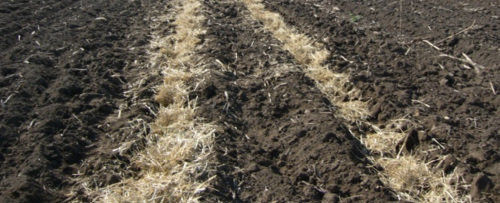
When a tree exhibits signs of ill health or exhaustion, vertical mulching is a highly effective solution to rejuvenate its root system. Vertical mulching is a technique designed to alleviate soil compaction within the CRZ of trees, preventing damage from excessive water during wet periods and facilitating sub-soil water penetration during dry periods. This method also promotes the formation of fine feeder roots.
How Vertical Mulching Works
Vertical mulching involves specialized tools creating holes in a grid pattern across the root zone of a tree affected by soil compaction. Following this, organic materials like mulch and rich compost are placed into the holes and a fresh layer of mulch is spread over the entire area. This time-tested technique helps trees thrive even in the most unnatural environments by creating cores of nutrient-rich "topsoil" down past the grass roots and into the soil area where tree roots can take advantage of them.
Advantages of Vertical Mulching
Vertical mulching offers numerous benefits for tree roots, simultaneously achieving the following:
- Aerating the Soil: It manually aerates the soil precisely where the roots are located.
- Improving Oxygen and Water Availability: It frees up more room in the soil for water and oxygen, both crucial for healthy root development.
- Enhancing Soil Health: Organic materials added during vertical mulching break down in the soil, providing sustenance for beneficial microorganisms and improving root aeration.
- Facilitating Water Penetration: It promotes water penetration into the subsoil during dry weather periods.
- Aiding Natural Aeration: It encourages natural aeration during wet weather periods.
- Reducing Root Damage: It minimizes root damage caused by excess water.
- Boosting Feeder Root Formation: It stimulates the formation of a greater number of feeder roots, essential for the tree's nutrition.
The Importance of Soil Health
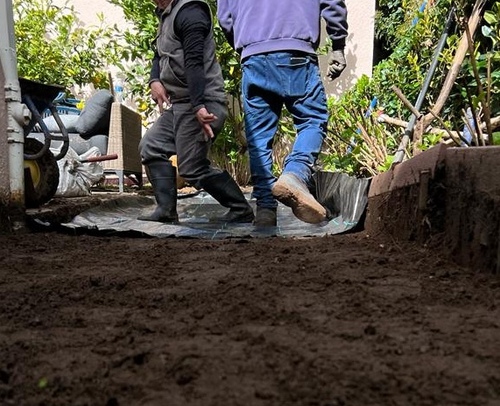
Healthy Soil Ensures the Sustainability of an Outdoor Planting Project
In addition to vertical mulching, it's vital to maintain the overall health of the soil within the CRZ. Healthy soil is the foundation of a thriving tree, providing essential nutrients and support for root growth. To ensure soil health, consider practices like regular soil testing and the incorporation of organic matter, such as compost, to enrich the soil with nutrients and beneficial microorganisms.
Nutrient Management for Trees
Ensuring that trees receive adequate nutrients is a key aspect of tree care. Nutrient deficiencies can significantly impact a tree's health and vitality. Here are some essential nutrients for tree growth:
Nitrogen
Nitrogen is essential for the formation of chlorophyll, the molecule responsible for photosynthesis. A lack of nitrogen can lead to pale or yellow leaves and stunted growth.
Phosphorus
Phosphorus is critical for energy transfer within the tree and for root development. A phosphorus deficiency can result in poor root growth and reduced fruit or flower production.
Potassium
Potassium plays a vital role in overall tree health, helping with water uptake and disease resistance. Trees deficient in potassium may exhibit scorched or discolored leaves.
Micronutrients
Micronutrients such as iron, zinc, and manganese are required in smaller quantities but are still essential for various tree functions. Micronutrient deficiencies can lead to a range of issues, including poor fruit quality and leaf discoloration.
Proper nutrient management involves regular soil testing to determine nutrient levels and adjusting fertilization accordingly. An arborist or tree care professional can help create a customized nutrient management plan for your trees.
The Role of Mycorrhizal Fungi
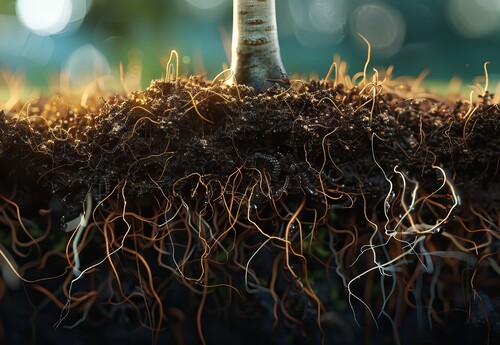
Roots and Mycorrhizal Fungi Work Together for Plant & Soil Health
Mycorrhizal fungi are beneficial organisms that form a symbiotic relationship with tree roots. These fungi extend the tree's root system by acting as an extension, helping the tree absorb water and nutrients more efficiently. Incorporating mycorrhizal fungi into your tree care regimen can enhance the tree's ability to access essential resources.
Symbiotic Relationship
Mycorrhizal fungi establish a symbiotic relationship with tree roots, forming intricate networks that extend the tree's root system beyond its physical reach. This symbiosis is essential for nutrient uptake, water absorption, and overall tree health.
Nutrient and Water Absorption
Mycorrhizal fungi play a crucial role in nutrient cycling. They can access nutrients, such as phosphorus and nitrogen, that may be otherwise inaccessible to tree roots alone. The fungi's extensive network enhances the tree's capacity to absorb water and nutrients from the soil, especially in nutrient-deficient or challenging soil conditions.
Improved Soil Structure
The presence of mycorrhizal fungi promotes soil aggregation and structure. The fungal hyphae create stable soil aggregates, improving soil aeration, water infiltration, and root penetration. This enhanced soil structure benefits not only the tree but also other plants and microorganisms in the ecosystem.
Enhanced Resistance to Stress
Trees with mycorrhizal associations exhibit increased resilience to environmental stressors such as drought, soil salinity, and disease. The fungi help buffer the tree against adverse conditions by improving water and nutrient availability, thus enhancing the tree's ability to withstand challenging environments.
Facilitating Root Growth
Mycorrhizal fungi stimulate root growth and branching, resulting in a more extensive and efficient root system. This increased root mass supports the tree's anchorage, nutrient uptake, and overall growth, contributing to its long-term stability and health.
Carbon Sequestration
Mycorrhizal fungi contribute to carbon sequestration by storing carbon in the soil as organic matter. This process not only benefits tree health but also helps mitigate climate change by reducing atmospheric carbon dioxide levels.
Environmental Benefits
The presence of mycorrhizal fungi in the soil enhances ecosystem resilience and biodiversity. They establish connections between different plant species, fostering nutrient exchange and cooperation among plants. This interconnectedness contributes to a healthier and more sustainable ecosystem.
Application in Tree Care
Incorporating mycorrhizal fungi into tree care practices can be highly beneficial. For instance, using mycorrhizal inoculants during tree planting or transplantation can jumpstart the symbiotic relationship and promote rapid root establishment. Additionally, maintaining healthy soil conditions that support mycorrhizal activity is crucial for ongoing tree health and vitality. Mycorrhizal Fungi can be easily found online, like on Amazon, so you can keep your trees healthy with the click of a button!
Professional Services for Tree Care
Property owners looking to maximize the benefits of vertical mulching and comprehensive tree care should consider seeking professional assistance. Arborist Now, a leading tree care service provider in the Greater San Francisco Bay Area, offers efficient and safe vertical mulching services for residential and commercial properties. Our team comprises certified arborists and landscape professionals who specialize in a wide range of tree care services, including tree pruning, tree planting, and irrigation installation, especially in Marin County.
Conclusion
Understanding the critical root zone, protecting it through vertical mulching, and maintaining soil health are essential for anyone who values trees and seeks to ensure their vitality. Additionally, nutrient management, the incorporation of mycorrhizal fungi, and professional tree care can further enhance a tree's resilience and overall well-being. By taking proactive steps to protect your trees and provide them with the care they deserve, you contribute to the long-term health of these natural wonders. Show your love for trees by nurturing their roots and securing their place in the landscape for generations to come. In doing so, you'll foster a legacy of healthy, thriving trees that stand as a testament to your deep-rooted commitment to their well-being and growth.
With this extended knowledge and holistic approach to tree care, you'll not only maintain the health of existing trees but also lay the foundation for a more vibrant and flourishing tree ecosystem for the future.
We may receive affiliate compensation for some of the links below at no cost to you if you decide to make a purchase.
Originally posted on March 7, 2017

